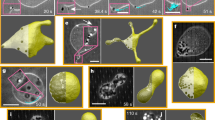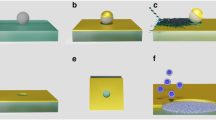Abstract
Bilayer membranes envelope cells as well as organelles, and constitute the most ubiquitous biological material found in all branches of the phylogenetic tree. Cell membrane rupture is an important biological process, and substantial rupture rates are found in skeletal and cardiac muscle cells under a mechanical load1. Rupture can also be induced by processes such as cell death2, and active cell membrane repair mechanisms are essential to preserve cell integrity3. Pore formation in cell membranes is also at the heart of many biomedical applications such as in drug, gene and short interfering RNA delivery4. Membrane rupture dynamics has been studied in bilayer vesicles under tensile stress5,6,7,8, which consistently produce circular pores5,6. We observed very different rupture mechanics in bilayer membranes spreading on solid supports: in one instance fingering instabilities were seen resulting in floral-like pores and in another, the rupture proceeded in a series of rapid avalanches causing fractal membrane fragmentation. The intermittent character of rupture evolution and the broad distribution in avalanche sizes is consistent with crackling-noise dynamics9. Such noisy dynamics appear in fracture of solid disordered materials10, in dislocation avalanches in plastic deformations11 and domain wall magnetization avalanches12. We also observed similar fractal rupture mechanics in spreading cell membranes.
This is a preview of subscription content, access via your institution
Access options
Subscribe to this journal
Receive 12 print issues and online access
$259.00 per year
only $21.58 per issue
Buy this article
- Purchase on Springer Link
- Instant access to full article PDF
Prices may be subject to local taxes which are calculated during checkout




Similar content being viewed by others
References
Clarke, M. S. F., Caldwell, R. W., Chiao, H., Miyake, K. & McNeil, P. L. Contraction-induced cell wounding and release of fibroblast growth factor in heart. Circ. Res. 76, 927–934 (1995).
Laporte, C. et al. A necrotic cell death model in a protist. Cell Death Differ. 14, 266–274 (2007).
McNeil, P. L. & Kirchhausen, T. An emergency response team for membrane repair. Nature Rev. Mol. Cell Biol. 6, 499–505 (2005).
Mehier-Humbert, S., Bettinger, T., Yan, F. & Guy, R. H. Plasma membrane poration induced by ultrasound exposure: Implication for drug delivery. J. Control. Release 104, 213–222 (2005).
Zhelev, D. V. & Needham, D. Tension-stabilized pores in giant vesicles: Determination of pore size and pore line tension. Biochim. Biophys. Acta, Biomembr. 1147, 89–104 (1993).
Sandre, O., Moreaux, L. & Brochard-Wyart, F. Dynamics of transient pores in stretched vesicles. Proc. Natl Acad. Sci. USA 96, 10591–10596 (1999).
Diederich, A., Strobel, M., Meier, W. & Winterhalter, M. Viscosity- and inertia-limited rupture of dextran-supported black lipid membranes. J. Phys. Chem. B 103, 1402–1407 (1999).
Evers, L. J., Shulepov, S. Y. & Frens, G. Rupture of thin liquid films from Newtonian and viscoelastic liquids. Faraday Discuss. 104, 335–344 (1996).
Sethna, J. P., Dahmen, K. A. & Myers, C. R. Crackling noise. Nature 410, 242–250 (2001).
Rosti, J., Illa, X., Koivisto, J. & Alava, M. J. Crackling noise and its dynamics in fracture of disordered media. J. Phys. D 42, 214013 (2009).
Richeton, T., Weiss, J. & Louchet, F. Breakdown of avalanche critical behaviour in polycrystalline plasticity. Nature Mater. 4, 465–469 (2005).
Zapperi, S., Castellano, C., Colaiori, F. & Durin, G. Signature of effective mass in crackling-noise asymmetry. Nature Phys. 1, 46–49 (2005).
Rädler, J., Strey, H. & Sackman, E. Phenomenology and kinetics of lipid bilayer spreading on hydrophilic surfaces. Langmuir 11, 4539–4548 (1995).
Homsy, G. M. Viscous fingering in porous media. Annu. Rev. Fluid Mech. 19, 271–311 (1987).
Akashi, K., Miyata, H., Itoh, H. & Kinosita, K. Formation of giant liposomes promoted by divalent cations: Critical role of electrostatic repulsion. Biophys. J. 74, 2973–2982 (1998).
Brochard-Wyart, F., Debregeas, G., Fondecave, R. & Martin, P. Dewetting of supported viscoelastic polymer films: Birth of rims. Macromolecules 30, 1211–1213 (1997).
Vilmin, T. & Raphael, E. Dewetting of thin polymer films. Eur. Phys. J. E 21, 161–174 (2006).
Wilkinson, D. & Willemsen, J. F. Invasion percolation: A new form of percolation theory. J. Phys A. 16, 3365–3376 (1983).
Aker, E., Måløy, K. J., Hansen, A. & Basak, S. Burst dynamics during drainage displacements in porous media: Simulations and experiments. Europhys. Lett. 51, 55–61 (2000).
Crandall, D., Ahmadi, G., Ferer, M. & Smith, D. H. Distribution and occurrence of localized bursts in two-phase flow through porous media. Physica A 388, 574–584 (2009).
Betterton, M. D. & Brenner, M. P. Electrostatic edge instability of lipid membranes. Phys. Rev. Lett. 82, 1598–1601 (1999).
Evans, E., Heinrich, V., Ludwig, F. & Rawicz, W. Dynamic tension spectroscopy and strength of biomembranes. Biophys. J. 85, 2342–2350 (2003).
Karlsson, M. et al. Electroinjection of colloid particles and biopolymers into single unilamellar liposomes and cells for bioanalytical applications. Anal. Chem. 72, 5857–5862 (2000).
Acknowledgements
This work was made possible through financial support obtained from the European Research Council (ERC Advanced Grant), The Swedish Research Council (VR) and the Knut and Alice Wallenberg Foundation.
Author information
Authors and Affiliations
Contributions
O.O. and T.L. conceived the original concept. I.G. carried out the microscopy experiments. P.D. developed the theoretical framework. I.C. and P.D. carried out data treatment and analysis of the fractal ruptures. A.J. carried out image analysis of pore edge regions. All authors contributed to writing the manuscript.
Corresponding author
Ethics declarations
Competing interests
The authors declare no competing financial interests.
Supplementary information
Supplementary Information
Supplementary Information (PDF 422 kb)
Supplementary Information
Supplementary Movie 1 (MOV 8650 kb)
Supplementary Information
Supplementary Movie 2 (MOV 17357 kb)
Rights and permissions
About this article
Cite this article
Gözen, I., Dommersnes, P., Czolkos, I. et al. Fractal avalanche ruptures in biological membranes. Nature Mater 9, 908–912 (2010). https://doi.org/10.1038/nmat2854
Received:
Accepted:
Published:
Issue Date:
DOI: https://doi.org/10.1038/nmat2854
This article is cited by
-
A Review of Benchmark Experiments for the Validation of Peridynamics Models
Journal of Peridynamics and Nonlocal Modeling (2019)
-
Rupturing cancer cells by the expansion of functionalized stimuli-responsive hydrogels
NPG Asia Materials (2018)
-
Lab on a Biomembrane: Rapid prototyping and manipulation of 2D fluidic lipid bilayer circuits
Scientific Reports (2013)



